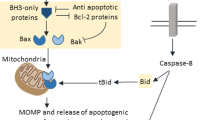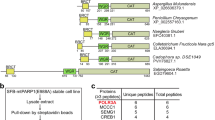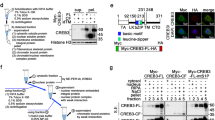Abstract
The execution of apoptosis or programmed cell death comprises both caspase-dependent and caspase-independent processes. Apoptosis inducing factor (AIF) was identified as a major player in caspase-independent cell death. It induces chromatin condensation and initial DNA cleavage via an unknown molecular mechanism. Here we report the crystal structure of human AIF at 1.8 Å resolution. The structure reveals the presence of a strong positive electrostatic potential at the AIF surface, although the calculated isoelectric point for the entire protein is neutral. We show that recombinant AIF interacts with DNA in a sequence-independent manner. In addition, in cells treated with an apoptotic stimulus, endogenous AIF becomes co-localized with DNA at an early stage of nuclear morphological changes. Structure-based mutagenesis shows that DNA-binding defective mutants of AIF fail to induce cell death while retaining nuclear translocation. The potential DNA-binding site identified from mutagenesis also coincides with computational docking of a DNA duplex. These observations suggest that AIF-induced nuclear apoptosis requires a direct interaction with DNA.
This is a preview of subscription content, access via your institution
Access options
Subscribe to this journal
Receive 12 print issues and online access
$189.00 per year
only $15.75 per issue
Buy this article
- Purchase on Springer Link
- Instant access to full article PDF
Prices may be subject to local taxes which are calculated during checkout



Similar content being viewed by others
References
Zamzami, N. & Kroemer, G. Nature Rev. Mol. Cell Biol. 2, 67–71 (2001).
Wang, X. Genes Dev. 15, 2922–2933 (2001).
Susin, S.A. et al. Nature 397, 441–446 (1999).
Green, D.R. Cell 94, 695–698 (1998).
Joza, N. et al. Nature 410, 549–554 (2001).
Susin, S.A. et al. J. Exp. Med. 192, 571–580 (2000).
Arnoult, D. et al. Mol. Biol. Cell 12, 3016–3030 (2001).
Miramar, M.D. et al. J. Biol. Chem. 276, 16391–16398 (2001).
Mate, M.J. et al. Nature Struct. Biol. 9, 442–446 (2002).
Holm, L. & Sander, C. Trends Biochem. Sci. 20, 478–480 (1995).
Senda, T. et al. J. Mol. Biol. 304, 397–410 (2000).
Ziegler, G.A., Vonrhein, C., Hanukoglu, I. & Schulz, G.E. J. Mol. Biol. 289, 981–990 (1999).
Kong, X.P., Onrust, R., O'Donnell, M. & Kuriyan, J. Cell 69, 425–437 (1992).
Luger, K., Mader, A.W., Richmond, R.K., Sargent, D.F. & Richmond, T.J. Nature 389, 251–260 (1997).
Uhlmann, F. Curr. Biol. 11, R384–387 (2001).
Demeret, C., Vassetzky, Y. & Mechali, M. Oncogene 20, 3086–3093 (2001).
Benbow, R.M. Science Prog. 76, 425–450 (1992).
Li, T.K. et al. Genes Dev. 13, 1553–1560 (1999).
Montague, J.W., Hughes, F.M. Jr & Cidlowski, J.A. J. Biol. Chem. 272, 6677–6684 (1997).
Otwinowski, Z. & Minor, W. Methods Enzymol. 276, 307–326 (1997).
Terwilliger, T.C. & Berendzen, J. Acta Crystallogr. D 55, 849–861 (1999).
Perrakis, A., Morris, R. & Lamzin, V.S. Nature Struct. Biol. 6, 458–463 (1999).
Brünger, A.T. et al. Acta Crystallogr. D 54, 905–921 (1998).
Jones, T.A., Zou, J.-Y., Cowan, S.W. & Kjeldgaard, M. Acta Crystallogr. A 47, 110–119 (1991).
Evans, S.V. J. Mol. Graph. 11, 134–138 (1993).
Nicholls, A., Sharp, K.A. & Honig, B. Proteins 11, 281–296 (1991).
Katchalski-Katzir, E. et al. Proc. Natl. Acad. Sci. USA 89, 2195–2199 (1992).
Loeffler, M. et al. FASEB J. 15, 758–767 (2001).
Daugas, E. et al. FASEB J. 14, 729–739 (2000).
Ravagnan, L. et al. Nature Cell Biol. 3, 839–843 (2001).
Acknowledgements
We thank N. Lue and J. Wang for discussions; the laboratories of H. Robertson, J. Darnel, S. Chen-Kiang and W. Muller for technical help and staff at the advanced photon source for assistance with data collection. This work was partially supported by a special grant from the Ligue contre le Cancer and the European Commission. H.Y. is a Revson postdoctoral fellow and H.W. is a Pew scholar of biomedical sciences and a Rita Allen Scholar.
Author information
Authors and Affiliations
Corresponding author
Ethics declarations
Competing interests
The authors declare no competing financial interests.
Rights and permissions
About this article
Cite this article
Ye, H., Cande, C., Stephanou, N. et al. DNA binding is required for the apoptogenic action of apoptosis inducing factor. Nat Struct Mol Biol 9, 680–684 (2002). https://doi.org/10.1038/nsb836
Received:
Accepted:
Published:
Issue Date:
DOI: https://doi.org/10.1038/nsb836
This article is cited by
-
p20BAP31 induces cell apoptosis via both AIF caspase-independent and the ROS/JNK mitochondrial pathway in colorectal cancer
Cellular & Molecular Biology Letters (2023)
-
Structural insights into FSP1 catalysis and ferroptosis inhibition
Nature Communications (2023)
-
Play of molecular host: guest assembly on a G-quadruplex binder
Journal of Inclusion Phenomena and Macrocyclic Chemistry (2023)
-
Landfill soil leachates from Nigeria and India induced DNA damage and alterations in genes associated with apoptosis in Jurkat cell
Environmental Science and Pollution Research (2022)
-
AIF3 splicing switch triggers neurodegeneration
Molecular Neurodegeneration (2021)



